It may be more low-key than some of its glitzy South Pacific neighbours, but humble Vanuatu offers adventure and chillax in equal plenty.
In this post, we’ve pulled together the pre-trip considerations and important things to know for visiting Vanuatu and exploring this unassumingly awesome corner of the South Pacific.
Why visit Vanuatu?
Beach lover? How about some pristine white sand and crystal clear water, pretty much to yourself? Adventure mad? Canyoning, trekking and kayaking awaits, along with the roiling, steaming heights of Mt Yasur volcano. For scuba junkies, Vanuatu is home to one of the world’s best shipwreck dives, along with fantastic reef and WWII relic dive sites.
Vanuatu’s culture is a story 2,500 years in the making, and the opportunities to experience and immerse in the vibrant traditions of the ni-Vanuatu people are many.
We decided to focus our first Vanuatu odyssey on just one of its 83 islands, and we’re glad we did. While it was the world class scuba diving in Vanuatu that first drew us in, we were blown away by how much there was to do on the island of Espiritu Santo alone.
Here’s a video we put together of our favourite highlights on Santo as a taster:
This may well be your biggest challenge once you decide to visit Vanuatu: what will you do with the time you have?
In the meantime, let’s get started with the things you need to know before visiting Vanuatu.
Where should you go in Vanuatu?
The Republic of Vanuatu is made up of 83 separate islands scattered over a distance of some 1,300 kilometres. That’s a lot of isle-and-ocean to navigate.
That said, only 65 or so of the islands are actually inhabited, and most tourists really only make it to a handful of them. With just ten days for our first Vanuatu visit, we opted to spend all our time on just one island – Espiritu Santo. At a glance though, these are some of the more popular islands for a trip to Vanuatu:
- Efate is Vanuatu’s main island and home to the capital, Port Vila. Most visitors start (and stay) here as it offers a good sampler of the archipelago, with waterfalls and beaches, cultural experiences, island day trips, nice snorkelling and diving, and the biggest concentration of shopping and dining.
- Espiritu Santo is Vanuatu’s biggest island and an adventure hub, with jungle trekking, river kayaking, pristine beaches, beautiful blue holes, and great reef and wreck scuba diving sites, including the world’s largest accessible shipwreck, the SS Coolidge. You can visit villages for cultural tours here too. Luganville is its main town.
- Tanna Island offers yet more diving and rainforest adventures, coffee plantations, upscale resorts, and a Vanuatu showpiece: the very accessible, very active Mt Yasur volcano.
- Pentecost Island is famous for the heart-in-mouth rite of passage naghol – a forerunner of bungee, where men leap from wooden towers with vines attached to their legs. It takes place between May and July.
- Maleluka Island is for cultural discovery, a place to learn about ancient islander traditions, including a not-so-distant cannibal past.
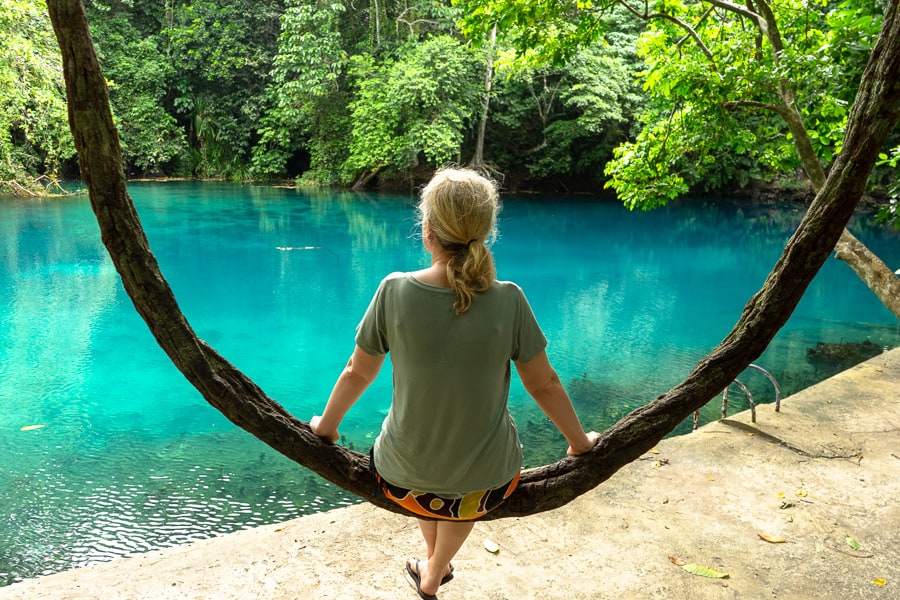
Do you need a visa for Vanuatu?
If you’re a citizen of a Commonwealth or EU country, or the US, you don’t need a visa to visit Vanuatu; you just need a passport with at least six months’ validity and an onward ticket. You get a 30-day stay on arrival, and this can be extended up to four months once you’re there.
There are a number of countries, however, that do require a visa for visiting Vanuatu – check out this link for more info.

How do you travel to Vanuatu?
There are two international airports in Vanuatu: Bauerfield International Airport near Port Vila on the main island of Efate, and Pekoa International Airport near Luganville on the island of Espiritu Santo.
Most international flights land at Port Vila, with domestic transfers to the other islands from there. You can reach Vanuatu’s capital, Port Vila, direct from Sydney and Brisbane in Australia, Auckland in New Zealand, Nadi in Fiji and Noumea in New Caledonia. There’s also a direct flight from Brisbane to the island of Espiritu Santo.
We took a 3.5 hour flight from Sydney to Port Vila, then a 50-minute domestic flight to Santo.
Airport taxes
There’s an international departure tax of VT2,500 (around USD$20) and an Air Vanuatu domestic departure tax of VT400 (appx USD$3.50). These are included in your airfare.
There’s also a separate domestic departure fee of VT200 (USD$1.70) for any flight out of the domestic airports at Port Vila, Santo, Emae, Epi and Tongoa. This is paid at the airport. We saw signs for it at the domestic airport in Port Vila, but it turns out you don’t need to pay this fee if you’re in transit.
Airport services
There’s very little going on at the international airports in Port Vila and Santo. The domestic airports are right next door.
We had an early morning flight out of Santo and there was a little café there serving food and coffee.
On our way home, we had a five hour layover in Port Vila. Given the very limited food choices at the airport, we decided to take a taxi into town to check out the markets and have something to eat (try the waterside Nambawan Café – a great spot to while away the time with nice meals and drinks).
We negotiated with our cabbie to come back and collect us a few hours later – total cost was VT3,000 (around USD$25). There were buses running into town from the airport which would be much cheaper, but less certain on the return.
How do you get between Vanuatu’s islands?
Getting between Vanuatu’s islands requires planning and time, so it pays to be realistic about how much you can see with the time you have.
By air
Air is by far the quickest way to get around the Vanuatu archipelago, though we’re generally talking small prop planes that book up quickly, so don’t leave planning to the last minute.
There are some charter companies flying the domestic routes, but Air Vanuatu is the main player on the domestic run between the islands (it has 24 internal destinations bookable online).
While it’s the fastest mode of transport, it’s worth noting that Vanuatu’s domestic flight program is notoriously unreliable (for a range of reasons), so give yourself plenty of time if you’re connecting with other flights or activities.
We worked out pretty quickly that time moves at a different pace in Vanuatu, and there’s no point stressing about slow moving check-ins and delayed flights. The locals definitely aren’t.
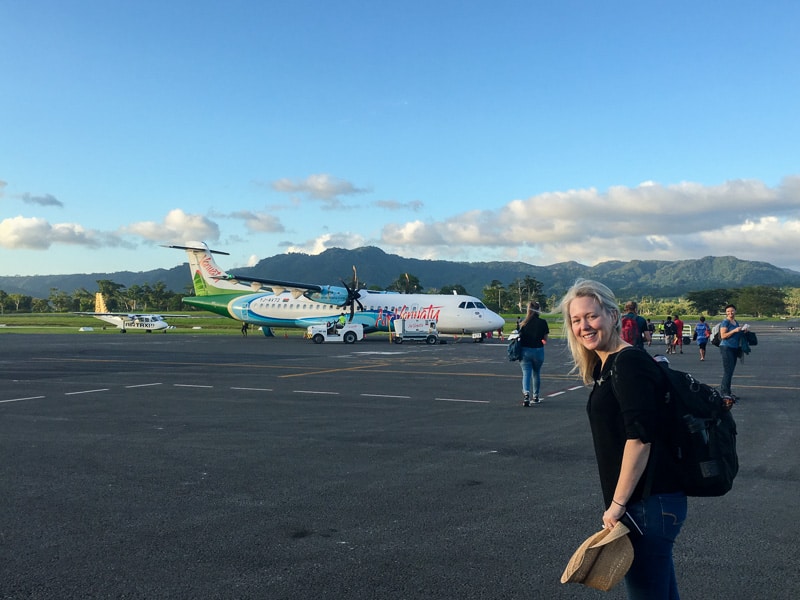
By sea
Boat is another way to travel between the islands but you will need (lots of) time and patience. For example, the two passenger ferries plying the route between Port Vila and Santo (a 50-minute flight) take around 24 hours. More if they decide to stop in at other ports on the way.
To be honest, the more we read about travelling between the islands by boat, unless your travels are open-ended, and you don’t mind very basic conditions, unpredictable schedules and potentially rough seas, take a plane.
What about getting around once you’re on an island?
Taxis
Getting around once you’re on an island is easy. On Santo, we made regular use of the taxis doing the main run to and from town. Taxis (usually little tin boxes with a sign on their roof) charged a flat fee of VT200 (around USD$1.70) for both of us – we made a point of checking this whenever we got in though. Apparently it’s more like VT500 (USD$4.30) in Port Vila.
If they’ve got room, taxis will stop even if they already have passengers, so we often found we were sharing with others, which was a nice way to get chatting with the locals.
Buses
Mini-buses are also common and can be flagged down anywhere – they have a B at the start of the number plate. On Santo, the fare was VT100 (about USD$0.85) per person for a short trip in town and from VT200 if travelling out of town (apparently it’s around VT150 in Port Vila).
Hitching
On a couple of occasions, we unintentionally hitched when people stopped to offer us a lift while we were walking. We’ve read that in these cases, the ride is usually free unless the driver has to go out of their way to drop you off. In our case, they did go out of their way, so we negotiated a fare, which was the same as a taxi trip. Ask before you get in if you’re unsure.
Car hire
We love the freedom that comes with hiring a car and Vanuatu was no exception, especially with Santo’s famous East Coast Road to explore.
Car hire certainly isn’t the only option for exploring the East Coast Road – you can hire a local to take you in their car, or join a guided tour taking in some of the key destinations. For us though, hiring a car was the perfect opportunity to explore this stunning coastal region at our own pace over a couple of days.
There are a couple of car hire companies in both Port Vila on Efate, and Luganville on Santo. We hired a zippy little SUV for two days for around VT18,000 (around USD$155). Vanuatu car hire isn’t a cheap option, and there are additional fees, like parking at Champagne Beach (VT2,000) and petrol, which all adds up. Still, we loved being able to stop where and when we wanted.
Public and private land in Vanuatu
Land in Vanuatu is either public land owned by the Government, or ‘kastom’ land which is privately owned by ni-Van traditional owners.
Visiting ‘kastom’ land requires permission from the land owners (you’ll often see ‘tabu’ signs at the entry to properties – it’s the origin of our word ‘taboo’ and means what it suggests – don’t go in without invitation).
There are specific places that can be visited by tourists, and these are managed by their kastom owners. You’ll often find there’s a local payment for visiting these places, which goes directly to the community.
At first we were a bit dubious about handing over cash to random people at the entrance to certain places, but we soon discovered this is normal and there’s a trust system at work. If you pay someone an entry fee, just ask their name so if you’re later asked by someone else, you can tell them who you paid.
If you want to get off the regular tourist trail, tour operators have often negotiated with kastom owners to access special places you won’t otherwise get to see.

What language do the people of Vanuatu speak?
The people of Vanuatu are called ni-Vanuatu (ni-Van for short), and while there are more than 100 local languages across the archipelago, the three official Vanuatu languages are Bislama, English and French.
Bislama is a form of pidgin English specific to the ni-Van and it’s the language you’ll hear most often, though just about everyone we met spoke English.
If you want to try a couple of Bislama words and phrases, good morning is ‘gudmoning’, how are you is ‘olsem wanem?’ and thank you is ‘tangkyu tumas’.
When is the best time to visit Vanuatu?
Vanuatu is in the tropics so it gets plenty of sunshine throughout the year. Still, the best time to visit is said to be between April and October. This is winter/spring, when temps are in the low to mid 20s.
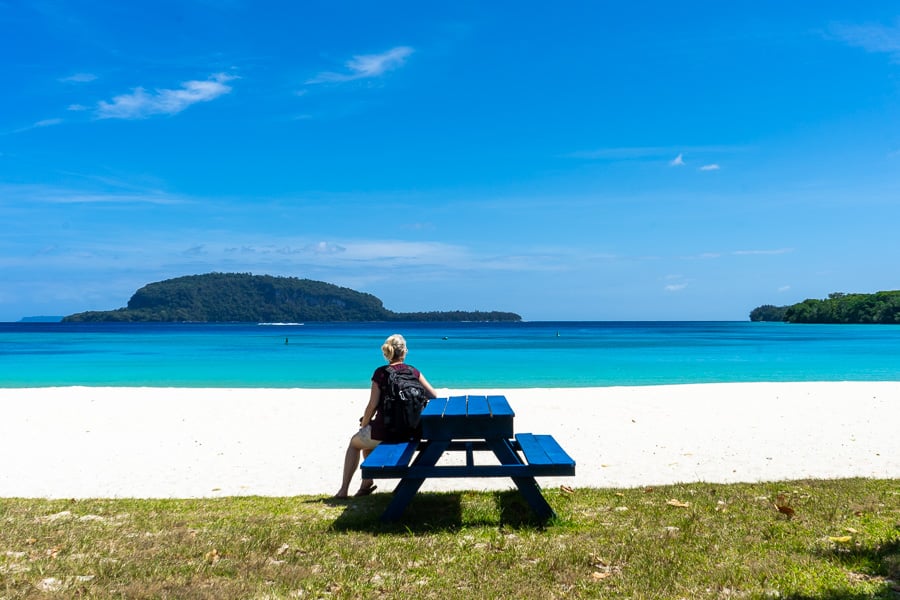
The wet season, from around November to March, is hot and humid. Temps are in the high 20s to low 30s. In true tropical fashion, downpours are heavy but brief. This is also cyclone season in the Pacific though, so if you’re planning a trip to Vanuatu at this time of year, keep an eye on the weather reports.
Peak season in Vanuatu is from June to August and mid-December to the end of January. The New Zealand and Australian school holidays are particularly busy, so check ahead as prices go up during these periods.
Our Vanuatu visit was in late October and while the daytime temps were in the high 20s, lovely cool southerlies would pick up each afternoon to cool the air, and we had occasional overnight rains. Most days started overcast, clearing in the afternoons to deliver stunning blue skies.
As scuba divers, sea temps are always an important consideration for us too (we’re no fans of chilly diving). Vanuatu’s waters range from around 22 to 28 degrees throughout the year, and averaged around 26 degrees for our dives in October, which suited us just fine.

Money matters
Currency
Vanuatu’s currency is the ni-Vanuatu vatu. You may see it written up as VUV or VT. It comes in coins and notes.
- Coins are in denominations of 1, 2, 5, 10, 20 and 100.
- Notes are in denominations of 200, 500, 1000, 5000 & 10000.
It’s good to have low denominations to hand for getting around and making local purchases.
We found most restaurants in town accepted credit cards, as did the supermarkets and our accommodation. Outside of the main towns and resorts though, have cash handy.
ATMs and banks
There are banks in Port Vila and Luganville, and easily accessible ATMs in both towns. You’ll also find ATMs at the airports, and money changers.
We made a point of getting money out from the ATM at the airport in Santo when we arrived, so we wouldn’t have to fuss once we got to our accommodation.
Is Vanuatu expensive?
While we’ve definitely been to more expensive destinations, we wouldn’t describe Vanuatu as a budget holiday. We found restaurant meals, car hire, entry fees and experiences to be similarly priced to Australia.
If you’re visiting lots of local sites in a day, entry fees can add up. These fees go directly to the community though and are an important contribution we can make as tourists.
Staying in a mid-range hotel bungalow with brekkie included, eating out some nights and buying other meals from the supermarket, using local transport and paying various entry fees, we spent an average of USD$155 per day for the two of us. Car hire, tours and scuba diving were extra.
There are lots of ways to save dollars while in Vanauatu; read on for suggestions about saving when it comes to accommodation, eating and drinking.
What is Vanuatu accommodation like?
You might be thinking Vanuatu is a luxury South Pacific holiday destination, but the country actually caters to range of budgets when it comes to accommodation.
Yes, there are some stunning waters-edge resorts and boutique stays, with the accompanying price tags. But there are also regular hotels, self-catering holiday rentals, hostels and simple beach shacks. You can also experience local life and culture with a stay in a traditional ni-Van village.
We even met a guy who was travelling with a tent and seeking permission from landowners to camp where he could.
We were keen on spreading our tourist dollar around, so on Santo we stayed at a hotel within walking distance of Luganville with a basic kitchenette. That way we could try different eateries, as well as pick up stuff from the local market and supermarket.
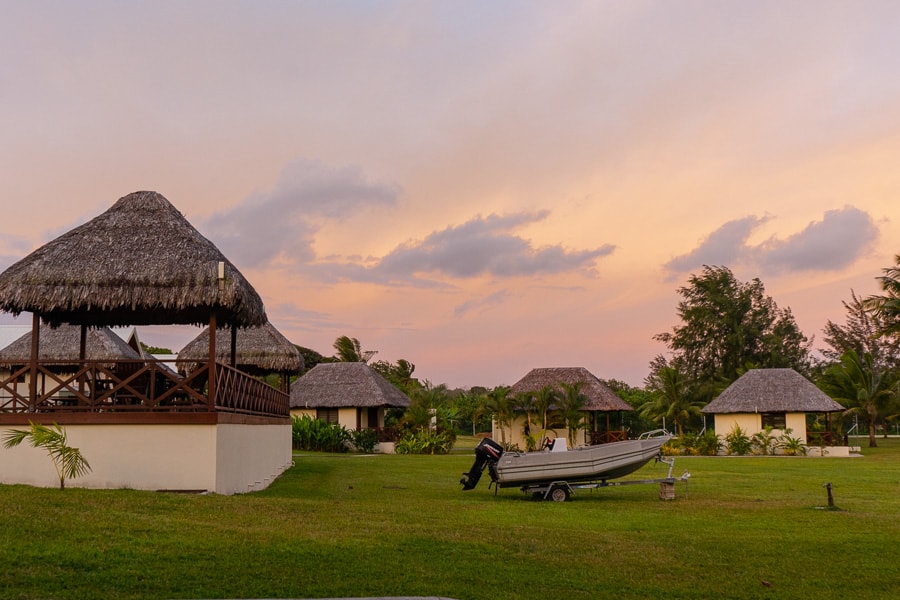
Vanuatu food and drink
Many ni-Van grow their own food or source it locally – be sure to visit a local market for a sense of Vanuatu food, and the sheer diversity and colour of the fruits and veg grown here (the markets in Port Vila and Luganville are on every day).
Poulet fish is a tasty white fish that turns up often on menus. Randomly, and unbeknown to us before our visit, Vanuatu beef is also considered top notch. Unsurprising, when you see the country’s chilled out cows grazing beneath palm trees on the coconut plantations.
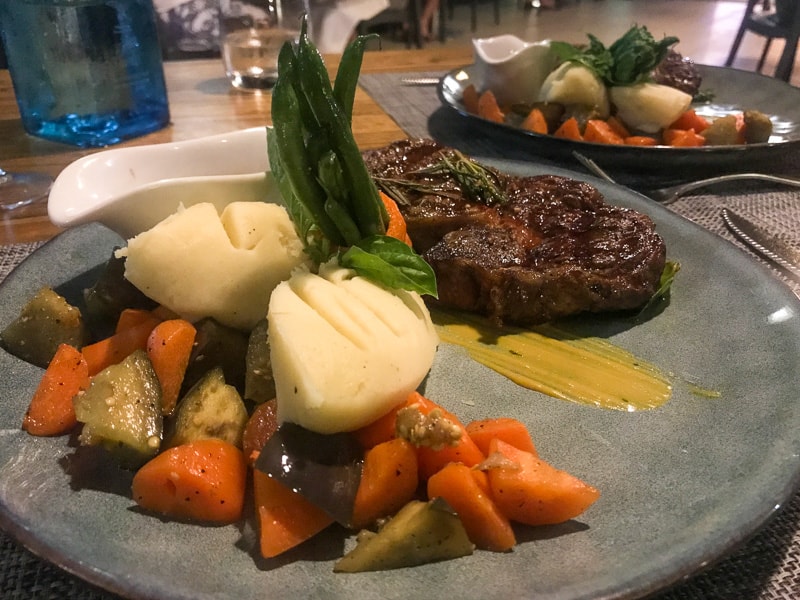
Speaking of coconuts, you’ll also find coconut crab – the world’s largest land-based invertebrate – a prized entry on some menus. However, it can take more than 40 years for these giants to reach full size, and they’re now an endangered species. Please don’t buy it.
Everything not grown or sourced locally has to be shipped in and the prices reflect it: we found the cost of food and drink in the restaurants and supermarkets to be similar to home.
We balanced our budget by eating out some nights and picking up items from the market and supermarket on others.
The Market Meal Booths at the market in Luganville are said to be a cheap and easy way to eat local. We didn’t get to try them alas as the markets were in the process of moving to a new location and the booths didn’t appear to be open.
When it comes to booze, it’s way cheaper to buy from the supermarket than at restaurants – literally half the price in the case of beer. We made a point of enjoying some supermarket-bought local craft beers on our balcony in the evenings rather than buying them in restaurants.
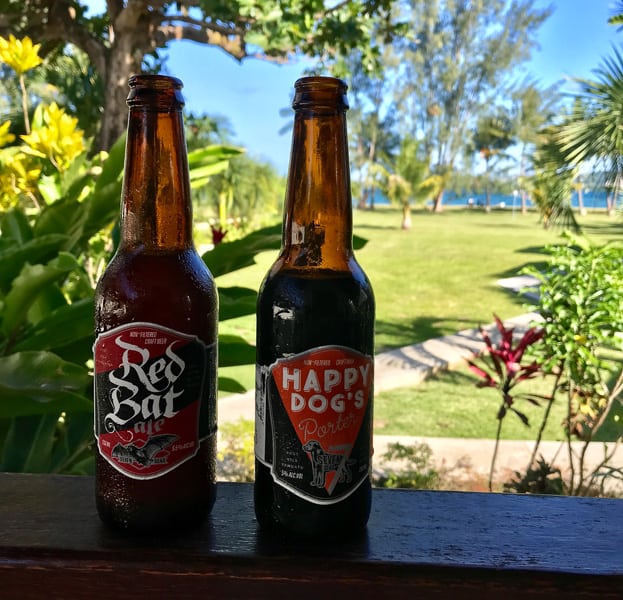
Is there wifi?
Wifi was available at our hotel free of charge, and this is apparently the norm, though some places do charge extra. We also found various cafes and restaurants had wifi for customers.
On the whole though, and perhaps unsurprisingly, the internet was generally patchy and slow. We took the cue and enjoyed a semi-digital detox instead.
How do I organise tours?
While we tend to travel independently, there are certain activities and experiences in Vanuatu that can only be done on an organised tour. With the kastom land ownership, tours also give you a chance to get off the tourist trail to see and experience parts of the islands and village life and culture that you wouldn’t otherwise get to.
There are plenty of great tours and activities on offer around Vanuatu, from cultural shows in local villages and kayaking adventures, to volcano hikes and the epic Millennium Cave tour on Santo (check out our video above for scenes from this fantastic daytrip).
It’s very easy to organise tours – either direct with tour agencies in the main towns, or via your accommodation. This site is also a great starting point for checking out the huge range of tour options across Vanuatu.
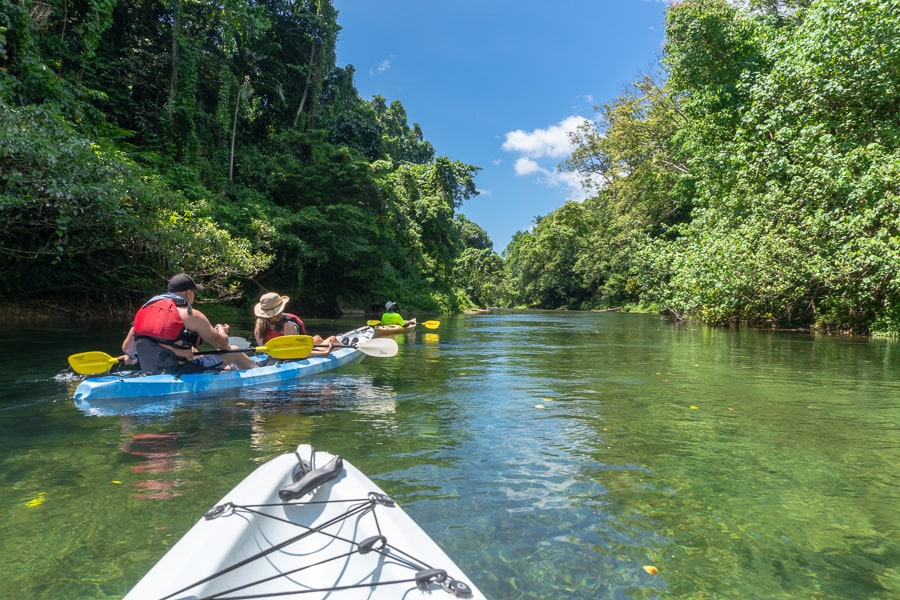
What health risks should you be aware of?
Like any destination, there are health matters you should be aware of before you travel to Vanuatu, and vaccinations that you should check are up to date. You should always have travel insurance.
Malaria is present in Vanuatu so discuss your options with your doctor before you go, along with any vaccinations you may need. Pack repellent with DEET, and long sleeves and pants.
DEET is also useful for other bitey insects, like ticks. I (Dan) was bitten by a tick while on a trek in the jungle on Santo. As it was on my back and we weren’t sure about removing it safely, we visited a local medical clinic in Luganville to get it dealt with. It was a simple and straightforward process and the cost was similar to what we would pay to visit a doctor in Australia.
Can you drink the tap water?
According to SmartTraveller, it’s safe to drink the tap water in Port Vila and Luganville, but outside these areas you should boil the water first or drink bottled water.
If you’re staying in a resort, check with them whether the tap water is ok. To avoid single use plastic, we suggest packing a steripen, or take a water bottle with a built-in purification system.
Where can I buy souvenirs?
The ni-Van make beautiful handicrafts, artworks, jewellery and clothes – buying from locals at the markets ensures your dollars are going direct to the community.
On Santo, check out the Luganville Women’s Handicraft shed off Main Street by the water, and Mama Handicraft back on Main Street.
In Port Vila, head to the Haos Blong Handikraft market by the waterfront near Numbawan Cafe.
There are some things to watch out for and know: Haggling isn’t a thing in Vanuatu. If you’re travelling via (or to) Australia as part of your Vanuatu trip, be aware that quarantine laws are extremely strict. There’s information available at the handicraft markets in Port Vila and Luganville that tells you what to look for when buying souvenirs.
You’ll also see shells and shell products. As with anywhere, avoid buying these if you can; they belong in the sea.
Packing essentials for visiting Vanuatu
Here are some key take-outs from our trip to help you pack for a perfect Vanuatu adventure:
- As a tropical destination, light and airy clothes are a must.
- Long pants and sleeves are good for evenings when mosquitos come out to bite.
- DEET repellent is also critical for keeping bitey beasties at bay.
- Sunscreen is vital, especially this close to the equator; if you’re swimming in the sea, aim for a reef-friendly sunscreen.
- Wear a hat and sunnies when you’re out during the day.
- With reefs to explore, dugongs to spot and blue holes to delve into, don’t forget to pack your snorkel and mask (and an underwater camera).
- Reef shoes are great for beach, sea and river adventures.
- Pack Plug Type I – the two and three-pin plugs used in Australia and New Zealand. Bring a global adaptor too, just in case.
- Bring a water bottle with built-in purifier, a steripen or water purification tablets, particularly if you’re staying outside of Port Vila and Luganville or a resort.

Got a question we haven’t answered here? Ask away below and we’ll see if we can help. Happy Vanuatu trip planning!

Am interested to visit your country this year October up to December Christmas holidays
Thanks David, I hope you make it to Vanuatu at some point – be sure to check health and entry requirements before you travel given the current COVID situation.
All the best, John and Danielle